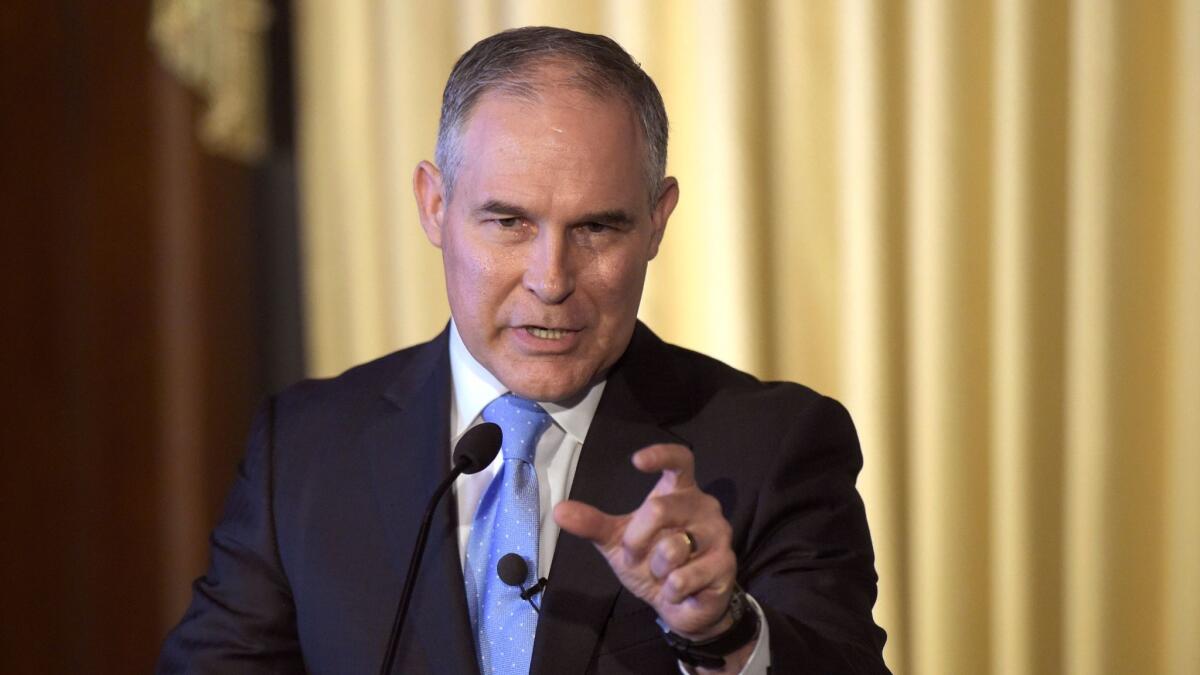Column: Trump’s EPA has started to scrub climate change data from its website

- Share via
Environmental advocates have been holding their breath since Jan. 20 against the moment when the Trump administration started to wipe information about the human effects on climate from the Environmental Protection Agency’s website.
That moment arrived Friday, when visitors to the site were greeted with a notice headed: “EPA Kicks Off Website Updates.”
The changes were being made to “reflect the agency’s new direction under President Donald Trump and Administrator Scott Pruitt,” the notice said. Old pages from the Obama era would be available through the site’s archive as is required by law, but “outdated” language is to be removed from the main pages. “Content related climate and regulations is also being reviewed,” the notice states.
As I watched more and more links turned red, I frantically combed the internet for archived versions of our country’s most important polar policies.
— Arctic researcher Victoria Herrmann
The changes already implemented on the site range from subtle to flagrant. As the EPA notice stated, the pages developed under the Obama administration are still accessible, but they’re harder to find—generally via a determined search. They’ve also been archived by environmental groups including NextGen Climate, which displays them here.
But “Climate Change” has been removed from the menu of “Environmental Topics” accessible from the agency’s home page. The website page for “climate change impacts” now displays a message stating the page is “being updated,” as does a link to the “main EPA climate change website.”
Friday’s changes weren’t the first alterations to the EPA website since the Trump inauguration. The advocacy group Climate Central noticed a number of deletions of or changes to pages devoted to Obama administration climate plans and tribal and international cooperative programs within days of Jan. 20.
Nor are the deletions and changes limited to the EPA website: Arctic researcher Victoria Herrmann reported noticing deletions of data related to Energy Department programs on Arctic climate starting the day after the inauguration. “As I watched more and more links turned red,” she wrote in the Guardian, “I frantically combed the internet for archived versions of our country’s most important polar policies.”
There’s nothing innocuous about these changes. They’re part of a deliberate policy to politicize what is perhaps the most important crisis facing the U.S. and the world and to turn the EPA into a promoter of corporate interests by disemboweling its regulatory functions. That’s a policy adopted by Pruitt, Trump’s EPA administrator, in his previous job as Oklahoma attorney general. Atty. Gen. Pruitt made a name for himself by suing the EPA over regulations aimed at cutting emissions, especially from the oil and gas industry, more than a dozen times.
Language on the EPA website documenting the human impact on climate also ran counter to Pruitt’s views as a climate change denier. “Measuring with precision human activity on the climate is something very challenging to do and there’s tremendous disagreement about the degree of impact,” he stated during an appearance on CNBC in March. “So no, I would not agree that it’s a primary contributor to the global warming that we see.”
That statement flatly contradicted the EPA’s own view of the causes of climate change available on its website. There, the agency stated that “it is extremely likely that human activities have been the dominant cause” of global warming.” The site explained that “recent climate changes...cannot be explained by natural causes alone. Research indicates that natural causes do not explain most observed warming, especially warming since the mid-20th century.”
As of today, that web page appears to be gone. A search for the page returns a notice that it’s being “updated.”
Keep up to date with Michael Hiltzik. Follow @hiltzikm on Twitter, see his Facebook page, or email [email protected].
Return to Michael Hiltzik’s blog.
More to Read
Sign up for Essential California
The most important California stories and recommendations in your inbox every morning.
You may occasionally receive promotional content from the Los Angeles Times.











